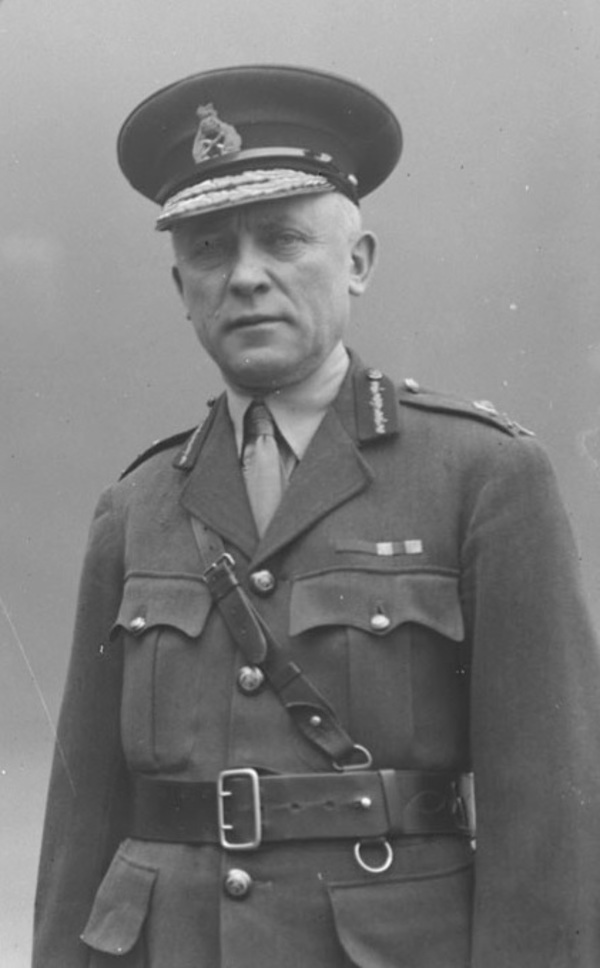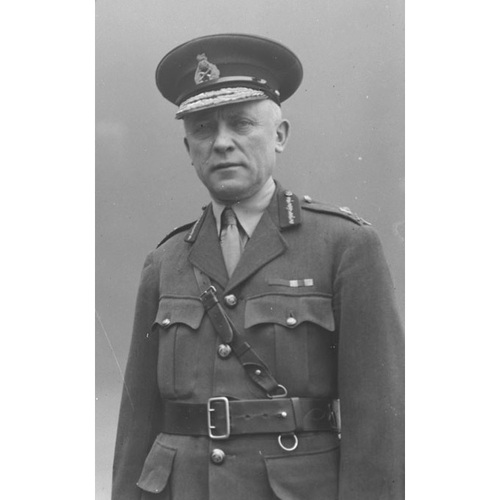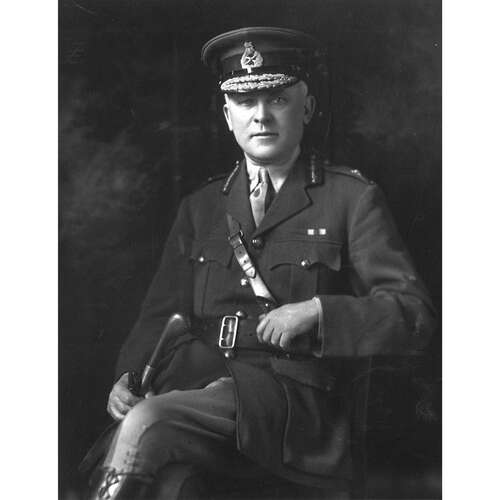
Source: Link
Stewart, JOHN WILLIAM, railway contractor, businessman, and military officer; b. 12 Dec. 1862 or 4 Dec. 1860 in Nedd, Sutherland, Scotland, son of William Stewart and Margaret McLeod; m. 31 Jan. 1894 Elizabeth Jane Moran in Helena, Mont., and they had one daughter; d. 24 Sept. 1938 in Vancouver.
Although most sources, including John William Stewart’s death record, list his birthdate as 12 Dec. 1862, the only birth record found for a “John” born to his parents (possibly a brother) is dated 4 Dec. 1860. John William, who often went by Jack, came from a poor family of crofters on the west coast of Scotland. Some sources claim that he went to university, and others suggest that he studied engineering before immigrating to Canada in 1882.
Stewart reportedly worked in a factory in Ontario before moving westward, apparently employed in railway construction. By 1885 he was working on a team surveying Granville (Vancouver) for the Canadian Pacific Railway (CPR), and the next year he was sent to Rogers Pass in the Rocky Mountains to supervise the construction of snow-sheds.
Stewart moved to the United States in the late 1880s, basing himself in Montana, to work for former CPR contractors. By 1890–91 he was the engineer in charge of construction for David C. Shepard, the contractor extending James Jerome Hill*’s Great Northern Railroad (GNR) west into Idaho. In 1892–93 he was the divisional engineer for Shepard, Peter Larson, and Horace Henry as the GNR was continued west to Puget Sound. Stewart further integrated himself into the community of railway contractors through his 1894 marriage to Elizabeth Moran, Larson’s sister-in-law. By the late 1890s he was based in Spokane, Wash., and working for the prominent firm of Foley Brothers, Larson and Company of St Paul, Minn., along with Patrick Welch, who married another Moran sister and would remain one of Stewart’s business partners for the rest of his life.
On behalf of the firm, Stewart supervised work on several railway lines in southeastern British Columbia, including the Kaslo and Slocan Railway (1895) and the Columbia and Western Railway (1900), both built in partnership with Donald Mann. The railway construction business was very fluid at the time; partnerships and companies were often formed for individual contracts and then dissolved. Stewart also managed construction on a line between Nelson and Balfour, the Nelson and Fort Sheppard Railway (1903–4). In 1905 he and Larson were hired to build a J. J. Hill feeder line to Grand Forks, which was the first time that Stewart was listed as a name partner on a contract. He travelled extensively within British Columbia and other parts of Canada, as well as the northwestern United States, conducting business and supervising construction sites. From about 1901 until about 1907, he made frequent trips to northern Ontario to supervise the double-tracking of the CPR main line between Port Arthur (Thunder Bay) and Winnipeg as well as the construction of the Lake Superior section of the competing Grand Trunk Pacific Railway (GTP).
In 1907 three of the senior partners in Foley Brothers, Larson and Company died. The four survivors, Timothy and Michael H. Foley, Patrick Welch, and Stewart, subsequently formed Foley, Welch, and Stewart (FWS), with offices in St Paul, Spokane, Prince Rupert, B.C., and Vancouver, where Stewart would live from at least 1909. The firm remained prominent in the pre-1914 railway boom in North America, at one point holding the contracts for more than 2,000 miles of line. From its creation to the beginning of the First World War, FWS employed nearly 50,000 men. By 1914 it had completed much of the GTP line from Winnipeg to Saskatoon, and all of it from that city to Prince Rupert. FWS double-tracked the CPR main line west of Winnipeg, built branch lines in Alberta, and between 1913 and 1916 constructed the Connaught Tunnel [see John Godfrey Sullivan] in British Columbia. It also built the Fraser Canyon section of the Canadian Northern Railway (CNR). In late 1913 FWS, in partnership with the Ottawa contractor Gilbert Emelius Fauquier, won the federal competition to build a new marine terminal in Halifax, which was completed in 1919, having been delayed by two years owing to the exigencies of the First World War. Typical of the larger railway contractors in this era of socio-political change, FWS developed the reputation of being a harsh employer. Conflict with organized labour, particularly the Industrial Workers of the World, had characterized GTP construction in British Columbia.
In diversifying their interests, Stewart and Welch had joined Washington lumberman Julius Harold Bloedel in Bloedel, Stewart, and Welch (BSW) as silent partners in 1911. Bloedel had previously worked with Peter Larson in forestry ventures and supplied construction materials to Larson and the Foley brothers. By 1911 Bloedel was expanding into British Columbia by setting up a Vancouver office, incorporating BSW, acquiring timberlands, and commencing operations at Myrtle Point. The initial viability of BSW was supported by substantial contracts from Stewart’s other ventures, including one from FWS for 1,800 carloads of lumber for GTP construction. On its formation in 1912, the Pacific Great Eastern Railway (PGE) contracted with BSW for the milled timber required for its construction. Following a decline during the war, in the 1920s BSW would expand its logging operations to Union Bay, Menzies Bay, and the Alberni area, and move into processing with a shingle factory and sawmills. In 1919–20 Stewart was vice-president, and in 1928 he bought many of Welch’s shares. By the time of Stewart’s death, BSW was a profitable logging and processing firm that dominated the sector on Vancouver Island.
In 1912 FWS, supported by the government of British Columbia, had entered railway proprietorship with the PGE. Ignoring Stewart’s competitors, the railway-boosting administration of Richard McBride* authorized FWS to connect the GTP main line in Prince George to Vancouver. In 1912 the partners incorporated the PGE, and then acquired the Howe Sound and Northern Railway to take advantage of its line between Squamish and Agerton (Pemberton). The PGE subcontracted the construction of the new line to Welch, and he resigned from the PGE; Stewart and Timothy Foley, who remained in the organization, also held interests in the deal. In April 1912 Stewart was reportedly recuperating from a severe illness in California and planning to leave for a year in Europe. In September he was elected president of the PGE and was involved in managing the company until 1915–16.
The financial downturn at the outbreak of the First World War had ended the railway boom, and FWS found itself embroiled in several lawsuits. To keep construction of the PGE going, McBride’s Conservative government authorized further funding even though the company’s contractual obligations had not been met. In 1916 Stewart went overseas to assume military duties, leaving the PGE in the hands of Donald McLeod (his agent), Welch, and D’Arcy Tate, the company’s vice-president and general counsel. In spite of allegations of corruption, work continued until late 1916, when John Oliver*, the minister of agriculture and railways for Harlan Carey Brewster*’s newly elected Liberal government, discovered serious irregularities, including a $5.7 million overpayment to the contractors. A select committee of the legislature was appointed to investigate. Tate was asked about his campaign contributions to the Conservatives, which he contended had come from his own pocket, and opposition leader William John Bowser, who had replaced McBride as Conservative leader and premier in late 1915, refused to answer questions about campaign funds. Stewart was in Europe and was not compelled to return because of his importance to the war effort. McLeod fled to Minnesota, and Welch and Tate, after denying any wrongdoing before the committee, both hastened to Seattle, Wash., to avoid further investigation. In May 1917 the government of British Columbia issued writs against the company, its subsidiaries, the contractors, and the individual directors, preventing further construction. Under the terms of a settlement reached in early 1918 with a Seattle lawyer representing the company, the government agreed not to prosecute the PGE, its subsidiaries, and their officials, and in exchange the government would receive all company assets, including real estate valued at about $22.5 million as well as an additional $1.1 million in compensation.
Thousands of miles away from the scandal, Stewart was pursuing his military career. His involvement with the armed forces had begun in 1910, when he sponsored the creation of the 72nd Regiment (Seaforth Highlanders), which named him honorary colonel in 1914. Responding to a British request for railway troops to serve in France, in 1915 Canada sent 500 men to form the Canadian Overseas Railway Construction Corps. In May 1916 the United Kingdom requested another thousand soldiers, and Stewart was commissioned a lieutenant-colonel, charged with organizing and commanding the 239th Infantry Battalion. He was appointed deputy director of general transportation (construction) in France before his arrival there as a brigadier-general in March 1917. That year three specialist Canadian railway-operating companies arrived in France, and Stewart organized units and redesignated others (including the 239th) into the 1st through 10th battalions, Canadian Railway Troops (CRT). In 1918 three more CRT battalions were formed. Stewart commanded more than 15,000 men, travelling to the various CRT units along the Western Front. He visited England regularly and participated in missions to Egypt in 1917 and Palestine in 1918. During the war he rose to the rank of major-general and was mentioned in dispatches four times. He was decorated with the dso and made a cmg and a cb. On 25 Jan. 1919 he left for England, and in March he arrived in Canada.
When Stewart returned to civilian life, Welch was in Seattle, where he had moved FWS’s headquarters. The two remaining Foley brothers died in 1920, and the business appears to have dissolved at that time. Stewart continued to work with Welch in BSW and in the new contracting firm Stewart and Welch, which they had established in 1919 with offices in Vancouver and Calgary. The enterprise would build various lines for the CPR and, ironically, for the PGE. Additionally, he organized J. W. Stewart and Company, with Vancouver and Winnipeg offices, which was employed by the CNR in the prairies. In 1921 the firm joined forces with the Winnipeg-based Northern Construction Company. Together, they built part of the Ballantyne Pier in Vancouver in 1922–23 and part of a pulp and paper plant in Newfoundland starting in 1923. Soon afterwards, they were hired to construct the CPR tunnel under the city of Vancouver and the Second Narrows Bridge over Burrard Inlet, which was completed in 1925. Northern Construction had moved to Montreal in 1924 and was listed as being in partnership with J. W. Stewart in local directories two years later. They also worked on part of the Welland Canal in Ontario as well as marine terminals in Quebec City, Trois-Rivières, Cape Tormentine, N.B., and Borden (Borden-Carleton), P.E.I. In 1928 Stewart travelled to New Zealand to bid on a railway-tunnel project. Later that year he was part of a multinational consortium that won the contract for an Iranian rail line. He continued his association with Northern Construction until his death.
After the First World War, Stewart had formed the partnership of Stewart and MacDonnell Limited, based in London, with his wartime aide, Lieutenant-Colonel Angus MacDonnell. By lobbying military colleagues there, the firm won a $17 million contract to construct a deep-water port and connecting railway at Takoradi (Sekondi-Takoradi) in the Gold Coast colony (Ghana). Former officers of the CRT made up most of the supervisory personnel, with MacDonnell assuming site responsibility in 1921 while Stewart liaised in London. Significant problems with the project, particularly cost overruns and rapid staff turnover, led the Colonial Office to end the contract in 1924.
Stewart participated in ventures outside his primary businesses. Owing to construction requirements, Stewart and Welch had invested in Western Explosives Limited, which operated a dynamite plant and a black-powder factory on Bowen Island in British Columbia from 1908 to 1913. The partners owned real estate in Vancouver and mining properties in the Fraser valley. To win support for FWS during the PGE scandal, in 1917 Stewart gained control of the Vancouver Sun, which was aligned with the newly elected provincial Liberal Party, although Stewart also maintained connections with the provincial Conservatives. Stewart put his secretary, Robert James Cromie, in charge of the daily while he was in Europe; when he returned, Cromie acquired the paper from him under circumstances that remain mysterious. In the late 1930s Stewart was a director of the London and Western Trusts Company Limited.
By 1920 Stewart and his family had moved into a mansion that he called Ardvar (the name of a village next to his hometown in Scotland) in Vancouver’s prestigious Shaughnessy Heights district. He had begun to demonstrate his wealth and status well before that time. First, around 1911 he bought a Rolls-Royce Silver Ghost touring car, which he used until the mid 1920s. Secondly, while in Great Britain in 1912–13, he purchased 135,000 acres of land in Scotland, which made him the landlord of the parish of Assynt, including Nedd, his natal village. Perhaps owing to inadequate rental income, in 1923 his agent began selling off individual lots to residents. Two years later Stewart used the property as collateral on loans, which would be discharged in 1936 when he sold the remainder of the estate for £60,000, about half the original purchase price.
At the height of their influence, the Stewart family hosted a dinner party for the Prince of Wales, later King Edward VIII, and his brother Prince George, when they visited Canada in 1927. As the ranking military officer in Vancouver in the 1920s and 1930s, Stewart participated in military ceremonies, such as receiving the salute from the Seaforth Highlanders on the 25th anniversary of their founding in 1935 and reviewing the troops for the coronation of King George VI in 1937. Stewart was a Presbyterian and a 32nd-degree mason. Following his wife’s death in 1935, he remained at Ardvar together with his daughter and her family. His health declined and he died of a heart attack in 1938, receiving full military honours at his funeral, which was attended by many of Vancouver’s elite.
Following his death, Stewart was described in the Vancouver Daily Province as “one of the [city’s] few real titans,” and among the richest and most powerful men in British Columbia. His ability to engage and network with a wide range of people contributed to his great success in business. In 1908, when he was managing construction of the GTP, the Daily Colonist (Victoria) wrote of him, “He has a charming personality, and his friends are legion, due to his loyalty and unobtrusive manner.” According to British Columbia politician Ian Alistair Mackenzie*, a close friend who had grown up in the same district of Scotland, Stewart was a “keen & intense Highlander” who appreciated the language and music of his homeland, said his nightly prayers in Gaelic, and was involved with the Scottish community in Vancouver from the time of his arrival. Obituarists described him as a patriotic Canadian who acknowledged that he owed his success to his adopted country. It is significant that they overlooked less-flattering episodes, such as his role in the PGE affair or the failure of the Gold Coast undertaking, in favour of his contributions to national development through railway and public-works projects, his status as a war hero, and, perhaps most of all, his trajectory from poverty to wealth and power, exemplifying the immigrant dream of self-made success in Canada.
Ancestry.com, “Montana, U.S., county marriages, 1865–1987,” J. W. Stewart and Eliza Moran, 31 Jan. 1894; “Scotland, select births and baptisms, 1564–1950,” John Stewart, 4 Dec. 1860: www.ancestry.ca (consulted 23 June 2017). BCA, GR-2951, 1938-09-547877; PR-0391, MS-0106 (Pacific Great Eastern Railway papers), box 1. Daily Colonist, 5 April 1908. Vancouver Daily Province, 24, 25, 26, 27, 28 Sept. 1938. Vancouver Sun, 24, 25, 26, 27, 28 Sept. 1938. B.C., Legislative Assembly, Sessional papers, 1917 (proceedings and evidence in re Pacific Great Eastern Railway Company …); Sessional papers, 1924 (report re the Pacific Great Eastern Railway). Canadian annual rev., 1917–18. Canadian Railway and Marine World (Toronto), 1911–38. E. T. Foley, Seventy years: the Foley saga (Los Angeles, 1945). Donald MacKay, Empire of wood: the MacMillan Bloedel story (Vancouver and Seattle, 1982). G. W. L. Nicholson, Canadian Expeditionary Force, 1914–1919: official history of the Canadian army in the First World War (Ottawa, 1962). Bruce Ramsey, PGE: railway to the north (Vancouver, 1962). P. J. Stephenson, “The Pacific Great Eastern Railway and British Columbia” (phd thesis, Univ. of B.C., Kelowna, 2012). G. W. Taylor, The railway contractors: the story of John W. Stewart, his enterprises and associates (Victoria, 1988).
Cite This Article
Jamie Morton, “STEWART, JOHN WILLIAM,” in Dictionary of Canadian Biography, vol. 16, University of Toronto/Université Laval, 2003–, accessed April 27, 2025, https://www.biographi.ca/en/bio/stewart_john_william_16E.html.
The citation above shows the format for footnotes and endnotes according to the Chicago manual of style (16th edition). Information to be used in other citation formats:
| Permalink: | https://www.biographi.ca/en/bio/stewart_john_william_16E.html |
| Author of Article: | Jamie Morton |
| Title of Article: | STEWART, JOHN WILLIAM |
| Publication Name: | Dictionary of Canadian Biography, vol. 16 |
| Publisher: | University of Toronto/Université Laval |
| Year of revision: | 2024 |
| Access Date: | April 27, 2025 |




